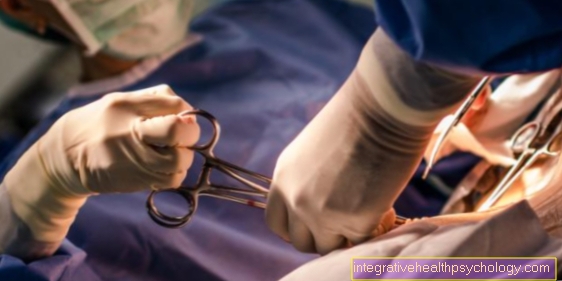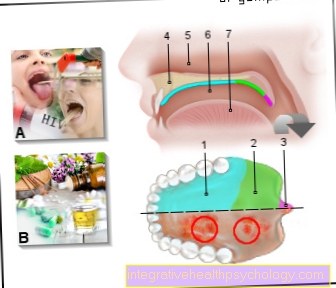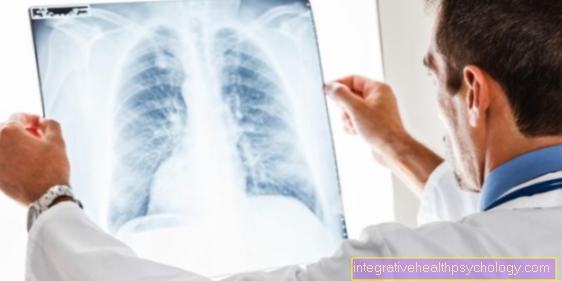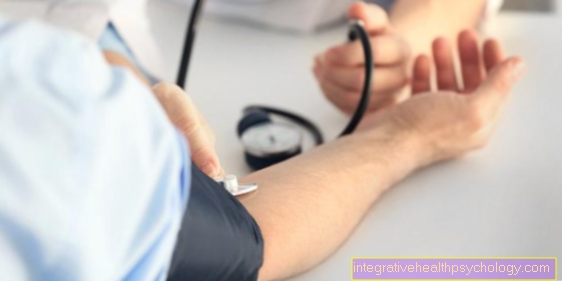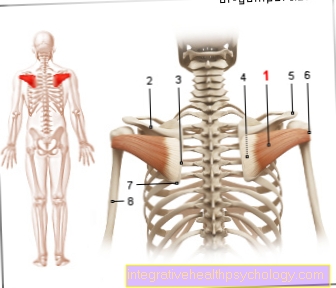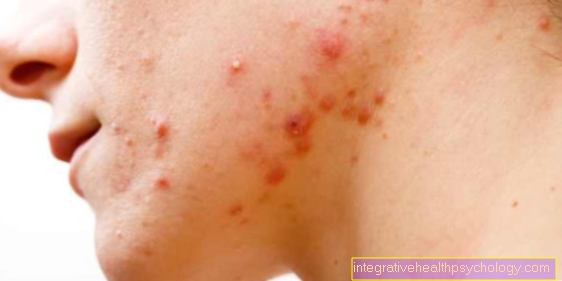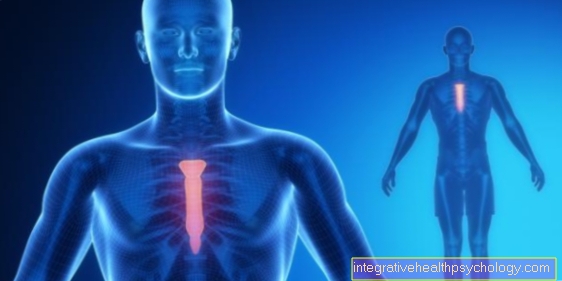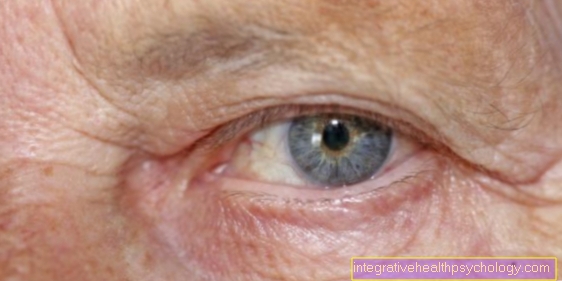Chromosomes
Definition - what are chromosomes?
A cell's genetic makeup is stored in the form of DNA (deoxyribonucleic acid) and its bases (adenine, thymine, guanine and cytosine). In all eukaryotic cells (animals, plants, fungi) this is present in the cell nucleus in the form of chromosomes. A chromosome consists of a single, coherent DNA molecule, which is linked to certain proteins.
The name chromosome is derived from Greek and can be roughly translated as "color body". This name comes from the fact that very early on in the history of cytology (1888), scientists succeeded in staining them using special basic dyes and identifying them in a light microscope. However, they are only really visible at a certain point in the cell cycle, mitosis (meiosis in germ cells), when the chromosome is particularly dense (condensed).

How are chromosomes structured?
If the entire DNA double helix of a cell, i.e. around 3.4 x 109 base pairs, were to be linked together, this would result in a length of over one meter. The total length of all chromosomes added is only about 115 µm. This difference in length is explained by the very compact structure of the chromosomes, in which the DNA is wound or spiraled several times in a very specific way.
Histones, a special form of proteins, play an important role in this. There are a total of 5 different histones: H1, H2A, H2B, H3 and H4. Two of the last four histones combine to form a cylindrical structure, the octamer, around which the double helix winds about twice (= super helix). H1 attaches itself to this structure in order to stabilize it.
This complex of DNA, octamer and H1 is called a nucleosome. Several of these nucleosomes are now “like a string of pearls” at relatively short intervals (10-60 base pairs) one behind the other. The sections between the chromosomes are known as spacer DNA. The individual nucleosomes now come into contact again via H1, which creates a further spiraling and thus also a compression.
The resulting strand is in turn present in loops, which are stabilized by a backbone made of acidic non-histone proteins, also known as Hertone. These loops are in turn in spirals stabilized by proteins, which results in the last stage of compression. However, this high degree of compression only occurs in the context of cell division during mitosis.
In this phase you can also see the characteristic shape of the chromosomes, which is composed of two chromatids. The place where these are connected is called the centromere. It divides each metaphase chromosome into two short and two long arms, also called p and q arms.
If the centromere lies roughly in the middle of the chromosome, it is called a metacentric chromosome; if it lies entirely at one of the ends of an acrocentric chromosome. Those in between are called submetacentric chromosomes. These differences, which can already be seen under the light microscope, together with the length, allow an initial classification of the chromosomes.
What are the telomeres?
Telomeres are the ends of the chromosomes with repeating sequences (TTAGGG). These do not carry any relevant information, but rather serve to prevent the loss of more relevant DNA sections. With each cell division, part of the chromosome is lost through the mechanism of DNA replication.
So the telomeres are, in a sense, a buffer that delays the point at which the cell loses important information through division. If the telomeres of a cell are less than 4,000 base pairs in length, programmed cell death (apoptosis) is initiated. This prevents the spread of faulty genetic material in the organism. A few cells have telomerases, enzymes that are able to lengthen the telomeres again.
In addition to the stem cells from which all other cells arise, these are germ cells and certain cells of the immune system. In addition, telomerases are also found in cancer cells, which is why one speaks of immortalization in this context of a cell.
Read everything about the topic here: Telomeres - Anatomy, Function & Diseases
What is chromatin?
Chromatin refers to the entire content of a cell nucleus, which can be stained with a base. Therefore, besides DNA, the term also includes certain proteins, e.g. Histones and Hertones (see structure), as well as certain RNA fragments (hn and snRNA).
Depending on the phase in the cell cycle or depending on genetic activity, this material is available in different densities. The denser form is called heterochromatin. To make it easier to understand, one could therefore regard it as a “storage form” and here again differentiate between constitutive and facultative heterochromatin.
Constitutive heterochromatin is the most dense form, which is present in its highest level of condensation in all phases of the cell cycle. It makes up about 6.5% of the human genome and is mainly located near the centromeres and the ends of the chromosome arms (telomeres) to a small extent, but also in other places (mainly chromosomes 1, 9, 16, 19 and Y). In addition, most of the constitutive heterochromatin is located near the nuclear membrane, i.e. on the edges of the cell nucleus. The space in the middle is reserved for the active chromatin, the euchromatin.
Facultative heterochromatin is a little less dense and can be activated and deactivated as required or depending on the stage of development. A good example of this is the second X chromosome in female karyotypes. Since one X chromosome is basically enough for the cell to survive, as is ultimately sufficient for men, one of the two is deactivated in the embryonic phase. the deactivated X chromosome is known as the Barr body.
Only during cell division, in the context of mitosis, does it condense completely, whereby it reaches its highest compression in the metaphase. However, since the different genes are read differently often - after all, not every protein is required in the same amount at all times - a distinction is made here between active and inactive Euchromatin.
Read more about this under: Chromatin
Haploid chromosomes
Haploid (Gr. Haploos = single) means that all chromosomes of a cell are present individually, i.e. not in pairs (diploid) as is usually the case. This is the natural state of all egg and sperm cells, in which the two identical chromatids are not initially separated as part of the first meiosis, but rather all chromosome pairs are separated first.
As a result, after the first meiosis, the daughter cells in humans only have 23 instead of the usual 46 chromosomes, which corresponds to half the haploid set of chromosomes. Since these daughter cells still have an identical copy of each chromosome consisting of 2 chromosomes, the second meiosis is required, in which the two chromatids are separated from each other.
Polytene chromosomes
A polytene chromosome is a chromosome made up of a large number of genetically identical chromatids. Since such chromosomes are easy to see under a lower magnification, they are sometimes referred to as giant chromosomes. The prerequisite for this is endoreplication, in which the chromosomes are multiplied several times within the cell nucleus without cell division occurring.
What are the functions of the chromosomes?
The chromosome, as the organizational unit of our genome, is primarily used to ensure that the duplicated genome is evenly distributed among the daughter cells during cell division. To do this, it is worth taking a closer look at the mechanisms of cell division or the cell cycle:
The cell spends most of the cell cycle in the interphase, which means the entire period of time in which the cell is not immediately about to divide. This in turn is divided into G1, S and G2 phases.
The G1 phase (G for gap, i.e. gap) immediately follows cell division. Here the cell increases in size again and performs general metabolic functions.
From here it can also switch to the G0 phase. This means that it changes to a stage that is no longer capable of dividing and, in normal cases, also changes greatly in order to fulfill a very specific function (cell differentiation). In order to fulfill these tasks, very specific genes are read more intensely, others less or not at all.
If a segment of DNA is not needed for a long time, it is often located in the parts of the chromosomes that are tightly packed for a long time (see chromatin). On the one hand, this has the purpose of saving space, but in addition to the other mechanisms of gene regulation, it is also an additional protection against being accidentally read. However, it has also been observed that, under very specific conditions, differentiated cells from the G0 phase can re-enter the cycle.
The G1 phase is followed by the S phase, i.e. the phase in which new DNA is synthesized (DNA replication). Here, the entire DNA must be in its loosest form, i.e. all chromosomes are completely uncoiled (see structure).
At the end of the synthesis phase, the entire genetic material is duplicated in the cell. Since the copy is still attached to the original chromosome via the centromere (see structure), one does not speak of a duplication of the chromosomes.
Each chromosome now consists of two chromatids instead of one, so that it can later assume the characteristic X-shape during mitosis (strictly speaking, the X-shape only applies to metacentric chromosomes). In the subsequent G2 phase, the immediate preparation for cell division takes place. This also includes a detailed check for replication errors and strand breaks, which can be repaired if necessary.
There are basically two types of cell division: mitosis and meiosis. With the exception of the germ cells, all cells of an organism arise through mitosis, the sole task of which is the formation of two genetically identical daughter cells.
Meiosis, on the other hand, has the purpose of generating genetically different cells:
In a first step, the corresponding (homologous) but not identical chromosomes are divided up. Only in the next step are the chromosomes, which consist of two identical chromatids, separated and again distributed to two daughter cells each, so that, in the end, four germ cells with different genetic material arise from one precursor cell.
The form and structure of the chromosomes are essential for both mechanisms: Special "protein threads", the so-called spindle apparatus, attach to the highly condensed chromosomes and pull the chromosomes in a finely regulated process from the mid-plane (equatorial plane) to the opposite poles of the cell around one to ensure even distribution. Even small changes in the microstructure of the chromosomes can have serious consequences.
In all mammals, the ratio of sex chromosomes X and Y also determines the sex of the offspring. Basically, it all depends on whether the sperm that unites with the egg cell carries an X or a Y chromosome. Since both forms of sperm are always produced to the exact same extent, the probability is always balanced for both sexes. This random system guarantees a more even gender distribution than would be the case, for example, with environmental factors such as temperature.
Find out more about the topic: Cell nucleus division
How are the genes passed on via the chromosomes?
Today we know that traits are inherited via genes that are stored in the cells in the form of DNA. These are in turn divided into 46 chromosomes, on which the 25,000-30000 human genes are distributed.
In addition to the property itself, which is called the phenotype, there is also the genetic counterpart, which is called the genotype. The place where a gene is on a chromosome is called a locus. Since humans have double every chromosome, every gene also occurs twice. The only exception to this are the X-chromosomal genes in men, as the Y-chromosome only carries a fraction of the genetic information found on the X-chromosome.
Different genes that are on the same locus are called alleles. Often there are more than two different alleles at one locus. One then speaks of polymorphism. Such an allele can simply be a harmless variant (normal variant), but also pathological mutations, which can be the trigger for a hereditary disease.
If the mutation of a single gene is sufficient to change the phenotype, one speaks of monogenic or Mendelian inheritance. Many of the inheritable traits, however, are inherited through several interacting genes and are therefore much more difficult to study.
Since mother and father each pass on one of their two genes to the child in a Mendelian inheritance, there are always four possible combinations in the next generation, whereby these can also be the same in relation to one property. If both alleles of an individual have the same effect on the phenotype, the individual is homozygous in relation to this characteristic and the characteristic is correspondingly fully expressed.
Heterozygotes have two different alleles that can interact with each other in different ways: If one allele is dominant over another, it completely suppresses its expression and the dominant trait becomes visible in the phenotype. The suppressed allele is called recessive.
In the case of a codominant inheritance, both alleles can express themselves unaffected by one another, while in the case of an intermediate inheritance there is a mixture of both characteristics. A good example of this is the AB0 blood group system, in which A and B are co-dominant with one another, but 0 are dominant over one another.
What is the normal set of chromosomes in humans?
Human cells have 22 sex-independent pairs of chromosomes (autosomes) and two sex chromosomes (gonosomes), so a total of 46 chromosomes make up one set of chromosomes.
Autosomes usually come in pairs. The chromosomes of a pair are similar in shape and sequence of genes and are therefore referred to as homologous. The two X chromosomes of women are also homologous, whereas men have an X and a Y chromosome. These differ in the form and number of genes present so that one can no longer speak of homology.
Germ cells, i.e. egg and sperm cells, have only half the chromosome set because of meiosis, namely 22 individual autosomes and one gonosome. Since the germ cells fuse during fertilization and sometimes swap entire segments (crossover), a new combination of chromosomes (recombination) is created. All chromosomes together are called the karyotype, which with a few exceptions (see chromosome aberrations) is identical in all individuals of the same sex.
Here you can find out everything about the topic: Mitosis - Simply Explained!
Why are there always pairs of chromosomes?
Basically, this question can be answered with one sentence: Because it has been shown to be beneficial. The presence of chromosome pairs and the principle of recombination are essential for inheritance in terms of sexual reproduction. In this way, a completely new individual can emerge from the genetic material of two individuals by chance.
This system enormously increases the variety of properties within a species and ensures that it can adapt to changed environmental conditions much faster and more flexibly than would only be possible through mutation and selection.
The double set of chromosomes also has a protective effect: if a mutation of a gene would lead to a failure of function, there is still a kind of "backup copy" in the second chromosome. This is not always enough for the organism to compensate for the malfunction, especially if the mutated allele is dominant, but it increases the chance of it. In addition, this way the mutation is not automatically passed on to all offspring, which in turn protects the species from overly radical mutations.
What is a chromosome mutation?
Genetic defects can arise from ionizing radiation (e.g. X-rays), chemical substances (e.g. benzopyrene in cigarette smoke), certain viruses (e.g. HP viruses) or, with a low probability, they can also arise purely by chance. There are often several factors involved in its development. In principle, such changes can occur in all body tissues, but for practical reasons the analysis is usually limited to lymphocytes (a special type of immune cell), fibroblasts (connective tissue cells) and bone marrow cells.
A chromosome mutation is a major structural change in individual chromosomes.The absence or addition of whole chromosomes, on the other hand, would be a genome or ploidy mutation, while the term gene mutation refers to comparatively small changes within a gene. The term chromosome aberration (Latin aberrare = to deviate) is somewhat broader and includes all changes that can be detected with a light microscope.
Mutations can have very different effects:
- Silent mutations, i.e. mutations in which the change has no effect on the individual or their offspring, are rather atypical for chromosome aberrations and are more often found in the area of gene or point mutations.
- A loss-of-function mutation is when the mutation results in a misfolded and therefore functionless protein or no protein at all.
- So-called gain-of-function mutations change the type of effect or the amount of proteins produced in such a way that completely new effects arise. On the one hand, this is a crucial mechanism for evolution and thus for the survival of a species or the emergence of new species, but on the other hand, as in the case of the Philadelphia chromosome, it can also make a decisive contribution to the development of cancer cells.
The best known of the different forms of chromosome aberrations are probably the numerical aberrations, in which individual chromosomes are only present once (monosomy) or even threefold (trisomy).
If this only applies to a single chromosome, it is called aneuploidy, and the entire chromosome set is affected by polyploidy (tri- and tetraploidy). In most cases, this maldistribution arises in the course of germ cell development due to non-separation (nondisjunction) of the chromosomes during cell division (meiosis). This leads to an uneven distribution of the chromosomes among the daughter cells and thus to numerical aberration in the developing child.
Monosomies of non-sex chromosomes (= autosomes) are incompatible with life and therefore do not occur in living children. With the exception of trisomies 13, 18 and 21, autosomal trisomies almost always lead to spontaneous abortions.
In any case, in contrast to the aberrations of the sex chromosomes, which can also be inconspicuous, there are always serious clinical symptoms and usually also more or less pronounced external abnormalities (dysmorphism).
Such a maldistribution can also occur later in life with mitotic cell division (all cells except germ cells). Since there are also unchanged cells in addition to the affected cells, one speaks of a somatic mosaic. With somatic (Greek soma = body) all cells are meant that are not germ cells. Since only a small part of the body's cells is affected, the symptoms are usually much milder. Therefore, mosaic types often go undetected for a long time.
Here you can find out everything about the topic: Chromosome mutation
What is chromosomal aberration?
Structural chromosome aberration basically corresponds to the definition of chromosome mutation (see above). If the amount of genetic material remains the same and is simply distributed differently, one speaks of a balanced aberration.
This often happens via translocation, i.e. the transfer of a chromosome segment to another chromosome. If it is an exchange between two chromosomes, one speaks of reciprocal translocation. Since only about 2% of the genome is required to produce proteins, the probability is very low that such a gene is at the breakpoint and thereby loses its function or is impaired in it. Therefore, such a balanced aberration often goes unnoticed and is passed on over several generations.
However, this can lead to a maldistribution of chromosomes during the development of the germ cells, which can lead to infertility, spontaneous miscarriages or offspring with an unbalanced aberration.
However, an unbalanced aberration can also occur spontaneously, i.e. without a family history. The probability that a child will be born alive with unbalanced aberration depends heavily on the chromosomes affected and varies between 0 and 60%. This leads to the loss (= deletion) or duplication (= duplication) of a chromosome segment. In this context, one speaks of partial mono- and trisomies.
In some cases these occur together in two different regions, with partial monosomy usually being more decisive for the appearance of clinical symptoms. These are prominent examples of a deletion Cat Scream Syndrome and Wolf-Hirschhorn Syndrome.
One speaks of a microdeletion when the change can no longer be determined with the light microscope, i.e. when it is a question of the loss of one or a few genes. This phenomenon is considered to be the cause of Prader-Willi syndrome and Angelman syndrome and is closely related to the development of retionoblastoma.
The Robertson translocation is a special case:
Two acrocentric chromosomes (13, 14, 15, 21, 22) unite at their centromere and, after losing the short arms, form a single chromosome (see structure). Although this results in a reduced number of chromosomes, this is referred to as a balanced aberration, as the loss of the short arms in these chromosomes can be easily compensated for. Here, too, the effects are often only noticeable in subsequent generations, as there is a very high probability of miscarriages or living children with a trisomy.
If there are two breaks within a chromosome, it can happen that the intermediate segment is rotated 180 ° and incorporated into the chromosome. This process, known as inversion, is only unbalanced if the break point lies within an active gene (2% of the total genetic material). Depending on whether the centromere is inside or outside the inverted segment, it is a peri- or paracentric inversion. These changes can also contribute to the uneven distribution of the genetic material on the germ cells.
In paracentric inversion, in which the centromere is not in the inverted segment, germ cells with two or no centromere can also appear. As a result, the corresponding chromosome is lost during the very first cell divisions, which almost certainly leads to a miscarriage.
Insertion refers to the incorporation of a chromosome fragment elsewhere. Here, too, the offspring are primarily affected in a similar way. A ring chromosome can occur especially after deletion of the end pieces. The type and size of the sequences are decisive for the severity of the symptoms. In addition, this can lead to incorrect distributions and thus in turn to mosaic types within the body cells.
If the metaphase chromosome separates incorrectly during cell division, isochromosomes can result. These are two exactly the same chromosomes that consist of only long or only short arms. In the case of the X chromosome, this can manifest itself as an Ulrich-Turner syndrome (monosomy X).
Read more about this topic: Chromosomal aberration
Trisomy 21
Trisomy 21, better known as Down syndrome, is probably the most common numerical chromosomal aberration among live births, with males being affected slightly more often (1.3: 1).
The probability of trisomy 21 occurring depends on various demographic factors, such as the average age at birth of the mothers, and varies slightly from region to region.
95% of the trisomy 21 arises as a result of a division error in the context of meiosis (germ cell division), namely nondisjunction, i.e. the failure to separate the sister chromatids.
These are referred to as free trisomies and arise 90% in the maternal, 5% in the paternal and another 5% in the embryonic genome.
Another 3% result from unbalanced translocations either on chromosome 14 or as 21; 21 translocation, creating a normal and a double chromosome 21. The remaining 2% are mosaic types in which the trisomy did not arise in germ cells and therefore does not affect all body cells. Mosaic types are often so mild that they can remain completely undetected for a long time.
In any case, a chromosome examination should be carried out in order to distinguish the symptomatically identical free trisomy from the possibly inherited translocation trisomy. A family history of the previous generations can then follow.
Are you interested in this topic? Read the next article on this: Trisomy 21
Trisomy 13
Trisomy 13 or Patau syndrome has a frequency of 1: 5000 and is much rarer than Down syndrome. The causes (free trisomies, translocations and mosaic types) and their percentage distribution are, however, largely identical.
In theory, almost all cases could be diagnosed prenatally using ultrasound or the PAPP-A test. Since the PAPP-A test is not necessarily part of the routine examinations, around 80% of cases in Central Europe are diagnosed before birth.
A growth residue, a bilateral cleft lip and palate and unusually small eyes (microphthalmia) can already be seen on ultrasound. In addition, malformations of the forebrain and face of different degrees of severity are usually present (holoprosencephaly).
While in the lobar form the cerebral hemispheres are almost completely separated and lateral ventricles are created, in the semi-lobar form often only the posterior part of the brain is separated and the lateral ventricles are missing. In the most severe form, the alobar form, there is no separation of the cerebral hemispheres.
Infants with a semi- or alobar shape usually die immediately after birth. After one month, the mortality rate is around 50% of live births. Until the age of 5, the mortality rate from trisomy 13 increases to 90%. Due to the malformations in the brain, in most cases the sick remain bedridden for life and cannot speak, which is why they are dependent on full care. In addition, there can also be extensive physical manifestations of Trismoie 13.
Read more on the subject at: Trisomy 13 in the unborn child
Trisomy 16
Basically, trisomy 16 is the most common trisomy (around 32% of all trisomies), but living children with trisomy 16 are very rare. In general, live births only occur in partial trisomies or mosaic types. Among the trisomies, it is most often responsible for stillbirths: 32 out of 100 miscarriages due to chromosomal aberrations can be traced back to this form of trisomy.
Therefore, mainly prenatally, i.e. prenatally, identifiable characteristics have been documented. Noteworthy here are various heart defects, slowed growth, a single umbilical artery (otherwise double) and increased neck transparency, which is explained by fluid accumulation due to the not yet fully developed lymph system and the increased elasticity of the skin in this area. In addition, the physiological umbilical hernia, i.e. the temporary displacement of a large part of the intestine through the navel to the outside, often does not regress properly, which is known as an omphalocele or umbilical cord break.
A flexion contracture with crossed fingers can also often be detected on ultrasound. In the few live births, generalized muscle hypotension, i.e. general muscle weakness, is noticeable. This leads to drinking weakness and can ensure that the infant has to be fed artificially. The four-finger furrow that is so characteristic of trisomies often occurs. Here, too, the frequency of occurrence of the trisomy is directly related to the age of the mother.
Trisomy 18
Edwards syndrome, i.e. trisomy 18, occurs with a frequency of 1: 3000. With prenatal diagnostics it is the same as with the Patau syndrome: Here too, the same examinations would allow all patients to be found completely before birth. The causes and their distributions are to be compared with other trisomies (see trisomy 21).
In addition, in trisomy 18 there are also partial trisomies which, like the mosaic types, lead to much milder clinical courses. The associated dysmorphisms are also extremely characteristic of Edwards syndrome: At birth, patients have a greatly reduced body weight of 2 kg (normal: 2.8-4.2 kg), a receding broad forehead, a generally underdeveloped lower half of the face with a small mouth opening , narrow eyelids and rotated backward, shape-changed ears (faun's ear). In addition, the back of the head is unusually well developed for a newborn. The ribs are unusually narrow and fragile. Newborns also have a permanent tension (tone) of the entire musculature, which, however, recedes after the first few weeks in the survivors.
Another characteristic feature is the crossing of the 2nd and 5th fingers over the 3rd and 4th with the total number of fingers hammered in, while the feet are unusually long (elapsed), have a particularly pronounced heel, stunted toenails and a set back big toe.
Serious organ malformations are common and usually occur in combination: heart and kidney defects, misfolding (malrotation) of the intestine, adhesions of the peritoneum (mesenterium commune), an occlusion of the esophagus (esophageal atresia) and many more.
Because of these malformations, the mortality rate is around 50% within the first 4 days, only around 5-10% live to be over a year. Survival into adulthood is the absolute exception. In any case, an intellectual disability is very pronounced and cannot speak, are bedridden and incontinent, so completely dependent on outside help.
For more detailed information on trisomy 18, please also read our detailed article on the subject:
- Trisomy 18 (Edwards Syndrome)
- Trisomy 18 in the unborn child
Trisomy X
Trisomy X is the most inconspicuous form of numerical chromosomal aberration, the appearance of those affected, who are logically all female, does not differ greatly from other women. Some are noticeable because they are particularly tall and have somewhat "plump" facial features. Mental development can also be largely normal, ranging from borderline normal to mild mental disability.
However, this intelligence deficit is a little more serious than with the other trisomies of the sex chromosomes (XXY and XYY). With a frequency of 1: 1000 it is actually not that rare, but since the trisomy is usually not associated with clinically significant symptoms, the majority of women with the disease will probably never be diagnosed for their entire life.
Carriers are mostly discovered by chance during a family check-up or during prenatal diagnostics. Fertility may be slightly reduced and the rate of sex chromosome aberrations in the next generation may be slightly increased, so that genetic counseling is recommended if you want to have children.
As with the other trisomies, trisomy X most often develops as a free trisomy, i.e. due to a lack of division (nondisjunction) of the sister chromatids. Here, too, it usually arises during the maturation of the maternal egg cells, although the probability increases with age.
Fragile X Syndrome
Fragile X syndrome or Martin Bell syndrome is preferred in men, as they only have one X chromosome and are therefore more affected by the change.
It occurs with a frequency of 1: 1250 among the male live births in one year, making it the most common form of unspecific mental retardation, i.e. all mental handicaps that cannot be described by a special syndrome with typical signs.
Fragile X syndrome can usually also occur in girls in a somewhat weaker form, which is due to the accidental inactivation of one of the X chromosomes. The higher the proportion of the switched off healthy X chromosome, the stronger the symptoms.
In most cases, however, women are carriers of the premutation, which does not yet produce any clinical symptoms, but increases the probability of full mutation in their sons massively. In very rare cases, men can also be the carriers of the premutation, which they can then only pass on to daughters who, however, are usually clinically healthy (Sherman paradox).
The syndrome is triggered by an extremely increased number of CGG triplets (a certain base sequence) in the FMR gene (fragile-site-mental-retardation); instead of 10-50 copies, the premutation 50-200, with full expression 200-2000 copies.
Under the light microscope, this looks like a break in the long arm, which is what gave the syndrome its name. This leads to the deactivation of the affected gene, which in turn causes the symptoms.
Those affected show a slowed development of speech and movement and can show behavioral problems that can lead to hyperactivity, but also to autism.Purely external abnormalities (signs of dysmorphism) are a long face with a prominent chin and protruding ears. With puberty, the testicles are often greatly enlarged (macroorchidia) and the facial features become coarser. There is a slight accumulation of psychological abnormalities and a particularly early menopause among female carriers of the premutation.
What is a chromosome analysis?
Chromosome analysis is a process in cytogenetics with which numerical or structural chromosome aberrations can be detected.
Such an analysis would be used, for example, if a chromosomal syndrome is immediately suspected, i.e. in the case of malformations (dysmorphisms) or intellectual disabilities (retardation), but also in the case of infertility, regular miscarriages (abortions) and also with certain cancers (e.g. lymphomas or leukemia).
This usually requires lymphocytes, a special type of immune cell that is obtained from the patient's blood. Since only a comparatively small amount can be obtained in this way, the cells are stimulated to divide with phytohemagglutinin and the lymphocytes can then be grown in the laboratory.
In some cases, samples (biopsies) are taken from the skin or spinal cord instead, and a similar procedure is used. The aim is to obtain as much DNA material as possible that is currently in the middle of cell division. In the metaphase, all chromosomes are arranged in one level approximately in the middle of the cell, in order to be drawn to the opposite sides (poles) of the cell in the next step, the anaphase.
At this point in time, the chromosomes are particularly tightly packed (highly condensed). The spindle poison colchicine is added, which works precisely in this phase of the cell cycle, so that the metaphase chromosomes accumulate. They are then isolated and stained using special staining methods.
The most common is GTG banding, in which the chromosomes are treated with trypsin, a digestive enzyme, and the pigment Giemsa. The particularly densely packed regions and the regions rich in adenine and thymine are shown dark.
The resulting G-bands are characteristic of each chromosome and, in simplified terms, are considered to be the regions with fewer genes. A picture of the chromosomes stained in this way is taken at a thousandfold magnification and a karyogram is created with the help of a computer program. In addition to the band pattern, the size of the chromosome and the position of the centromere are used to help arrange the chromosomes accordingly. There are also other methods of banding that can have very different advantages.
Recommendations from the editorial team
For more general information, see the following articles:
- Cell nucleus division
- Functions of the cell nucleus
- Trisomy 21
- Genetic diseases








